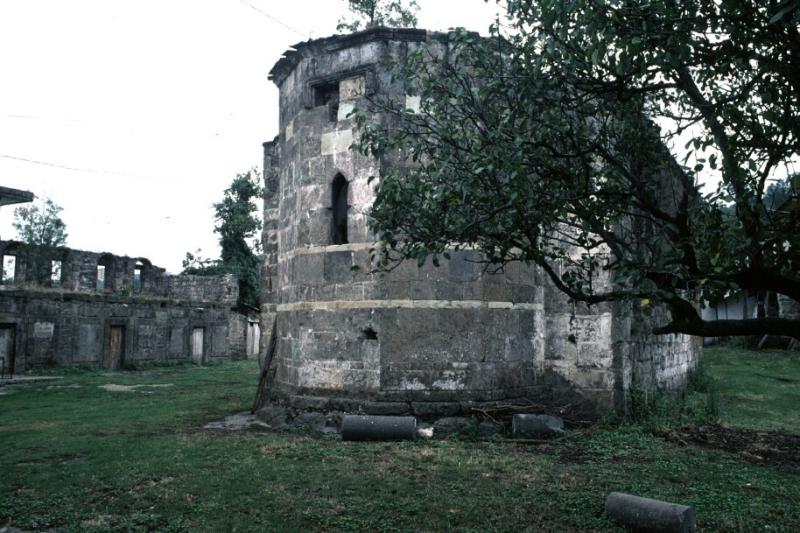- Kaymaklı Monastery
Infobox religious building
building_name=Monastery of the All-Saviour
Ամենափրկիչ Վանք
caption= Ruins of the "Kaymaklı Monastery". © Dick Osseman
location=Empire of Trebizond (modern-dayTurkey )
geo=
religious_affiliation=Armenian Apostolic
district=
consecration_year=
status=
leadership=
website=
architect=
architecture_type=Monastery , Church
architecture_style= |facade_direction=
year_started=
year_completed=1424
construction_cost=
capacity=
length=
width=
width_nave=
height_max=
dome_quantity=
dome_height_outer=
dome_height_inner=
dome_dia_outer=
dome_dia_inner=
minaret_quantity=
minaret_height=
spire_quantity=
spire_height=
materials=Kaymaklı Monastery ( _hy. "Ամենափրկիչ Վանք", "Amenaprgič Vank", meaning Monastery of the All-Saviour; _tr. Kaymaklı Manastırı, Amenapırgiç Manastırı) is a ruined Armenian Apostolic monastery near
Trabzon ,Turkey .The monastery originally included a church, a
bell tower at the northwest corner, and a smallchapel near the southeast corner.Location, founding and name
The monastery is located on top of Boztepe hill, three kilometres southeast of
Trabzon (Coord|40.9943|39.74418|display=inline,title|format=dms). The site overlooks the Değirmendere Valley, [cite web|last = Trabzon Governorship |url=http://www.trabzon.gov.tr/eng/church/monastery_kaymakli.aspx|title=Kaymaklı Monastery| accessdate = 2007-08-24] the ancient riverPyxites , along which runs the main trade route into eastern Anatolia and beyond.An Armenian community existed in
Trabzon as early as the 7th century.Ambart︠s︡umi︠a︡n, "Haykakan sovetakan hanragitaran", "Trapizon", p. 87] During theMongol invasions of the 13th and 14th centuries, numerous Armenian families fled here fromAni . However, exact date of the monastery's foundation and origin remains unclear. A religious community was present at the site from at least the fifteenth century, and possibly as early as the eleventh. The oldest structure in the compound is dated to 1424. In 1461 it was pillaged and destroyed by Turks. In the 16th century, the rebuilt monastery became a center of Armenian manuscript production.It was named Ամենափրկիչ Վանք (Amenaprgič Vank) in Armenian, which translates as "Monastery of the All-Saviour". The Ottoman Sultan
Murad III is said to have eaten a meal at the monastery consisting only of dairy products. He confirmed the monastery's possession of its lands, and the place came to be called in TurkishKaymaklı , meaning "with/ofkaymak ", in memory of the occasion. Previously it had been called "Yesil Manastir" - the "Green Monastery".Bryer, "Byzantine Monuments and Topography of the Pontos", pp. 208-211]Buildings
The site was a terrace enclosed by a wall 30 x 40m. The wall is now almost completely destroyed. The oldest surviving structure is a small chapel located at the eastern end of the compound. According to an inscription above the door, it was built in 1424 by prince Hodja Stephanos Shemsedli (Khoja Stepanos Shemsedin). The chapel has reused
khachkars in its walls. The original complex included a zhamatun, fountain known as the milk fountain, a tower, the mentioned chapel, and an arcaded monastic building.Main church
The main church is rectangular in form, with three
naves and threeapses . The main apse ispentagonal . The founding date for the church is not clear, but is believed to have been built on a surviving parts of a 12-13th centuryGreek church on the site. The original roof of the main church was made of timber and had fallen-in by 1929. In 1961 a replacement roof, also made of timber, was installed when the church began to be used as a barn. This roof is also now gone, and it is unclear whether the church is currently roofed. There was anarthex or zhamatun at the western end of the church, but it has entirely disappeared.The inside of the church is decorated with elaborate
frescoes showing various biblical scenes. They are believed to have been painted in the 17-18th centuries. On the west wall is a large fresco on three sections depicting theLast Judgment . North-west of the church are the remains of abell tower , once an extremely tall structure. South of the church are the remains of a 2-storymonastic building that had aportico with stonecolumns on the lower floor.Modern times
Until 1915 it served as the seat of the Trebizond diocese tied to the
Armenian Patriarchate of Constantinople .Köker, "Armenians in Turkey 100 Years Ago", p. 180] At this time, the vibrant Armenian community of the city numbered 30,000. In 1915, the normal functions of the monastery were interrupted when it was used as a transit camp for Armenians being deported toSyria during theArmenian Genocide . After the Russian capture of Trebizond, Armenian monks returned to the monastery, and monks were there until sometime afterWorld War I , [Ballance, "The Byzantine Churches of Trebizond", p. 169] supposedly 1923. [Darke, "Guide to Eastern Turkey and the Black Sea Coast", p. 327]A fire may have partially ruined the site at a later date. By the 1950s, the main church was roofless and most of the bell-tower had been destroyed. A farm now utilizes the remaining buildings of the Kaymaklı monastery.
See also
*
Kuştul Monastery
* Hagia Sophia cathedral of Trabzon
*Sümela Monastery Notes
References
*cite encyclopedia|last=Ambart︠s︡umi︠a︡n|first=Victor Amazaspovich|coauthors=Abel Poghosi Simonyan; Makich‘ Vahani Arzumanyan, |year= 1986|encyclopedia= Haykakan sovetakan hanragitaran ("Soviet Armenian Encyclopedia ") |volume= 12|location= Yerevan |pages = 87|id= oclc|10431241 |language=Armenian
*
*
*cite book
last = Darke
first = Diane
title =Guide to Eastern Turkey and the Black Sea Coast
publisher = Michael Haag
year =1987
location =London
isbn = 090274366X
*Cite book
last = Köker
first = Osman
title = Armenians in Turkey 100 Years Ago
publisher = Birzamanlar Yayıncılık
year = 2005
location = Istanbul
isbn = 975615800X
language=EnglishFurther reading
*
*
*
*External links
* cite web
last =Sim
first =Steven
title = Kaymakli
publisher =VirtualAni
url = http://www.network54.com/Forum/146256/message/1177269274/
accessdate = 2007-08-24* cite web
publisher = Kara Lahana
last = Kara Lahana
first =
title = Part 7:Boztepe
url = http://www.karalahana.com/english/archive/trabzon7.html
accessdate = 2007-08-24
* [http://www.pbase.com/dosseman/trabzonmonasteries&page=2 Photos of Kaymaklı Monastery by Dick Osseman]
Wikimedia Foundation. 2010.
